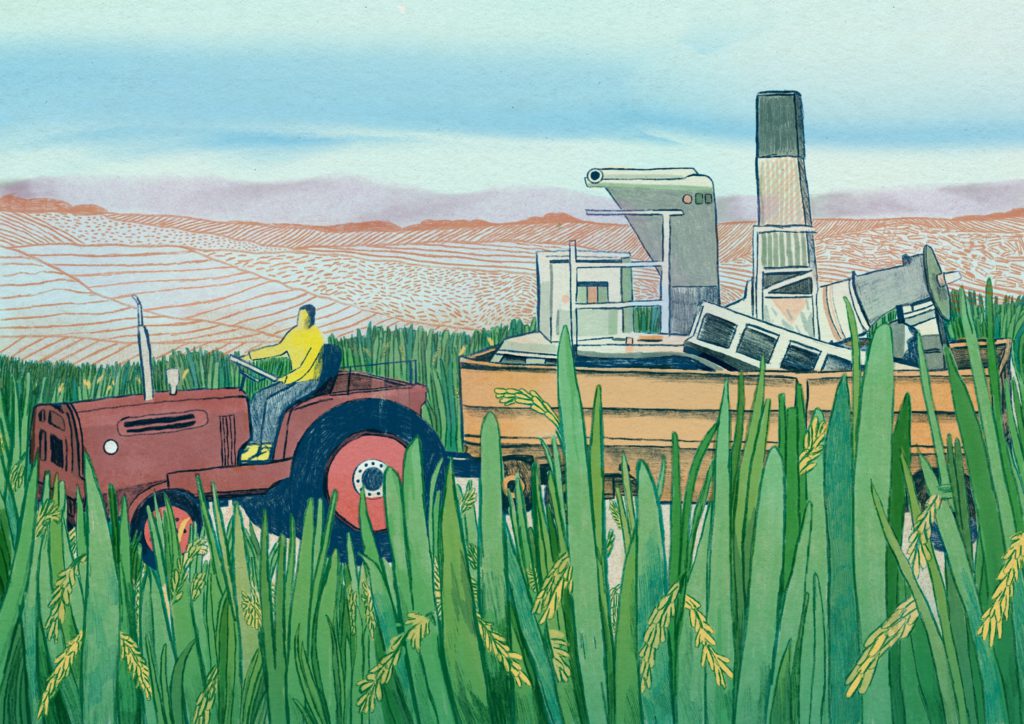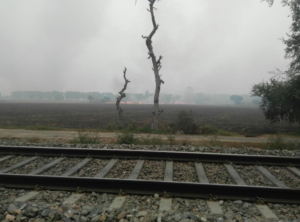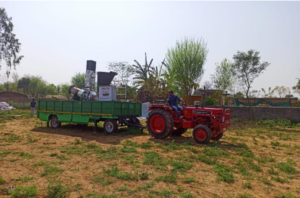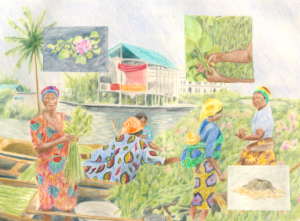
Pau Gasol
Descripción
La misión de Takachar es aumentar drásticamente la cantidad de residuos agrícolas y forestales (biomasa) que se convierten económicamente en bioproductos de mayor valor en comunidades rurales desatendidas de todo el mundo. La mayoría de los residuos de biomasa rural son sueltos, húmedos y voluminosos, lo que dificulta y encarece su recolección y transporte a un lugar centralizado para su conversión. El equipo de conversión de biomasa de pequeña escala, bajo costo y portátil de Takachar puede acoplarse a la parte trasera de tractores o camionetas para procesar localmente los residuos disponibles y transformarlos en bioproductos de mayor valor y carbono negativo, como mezclas de fertilizantes, productos químicos y biocombustibles.
Contexto
Después de la cosecha, muchos cultivos generan residuos en el campo que no pueden ser utilizados como mantillo o alimento para animales. La presencia de estos residuos suele dificultar el crecimiento del siguiente cultivo. Los agricultores generalmente tienen un margen de tiempo muy corto, de no más de 15 días, para despejar los residuos, como la paja de arroz o las cáscaras de maíz, y comenzar a preparar el terreno para la próxima siembra.
Hasta ahora, la forma más rápida y económica de eliminar estos residuos ha sido simplemente quemarlos en el campo, una práctica muy extendida en muchas economías emergentes, como la de India. Sin embargo, la quema de residuos se ha vinculado a la contaminación del aire, que afecta la salud respiratoria no solo de las comunidades agrícolas locales, sino también de centros urbanos cercanos como Delhi (Subramanian, 2016). Por esta razón, muchos gobiernos locales han comenzado a tomar medidas drásticas contra la quema de residuos al aire libre, llegando en algunos casos a multar a los agricultores.
Desde la perspectiva de los agricultores, no existe una alternativa factible a la quema de residuos al aire libre. Muchos de los agricultores con los que hemos hablado han ofrecido incluso pagar alrededor de $15 por acre (aproximadamente 3 días de trabajo por acre) para que empacadoras o intermediarios retiren los residuos de manera oportuna del campo, pero no han encontrado interesados (Mohan, 2018). La realidad es que los residuos de cultivos son sueltos, húmedos, voluminosos y están geográficamente dispersos, lo que los hace muy costosos (más de $15 por acre) de recolectar y transportar, ya sea a un sitio de eliminación o a una instalación centralizada para su posterior conversión en combustible, fertilizante u otros productos químicos.
En India, alrededor de 40 millones de agricultores siembran regularmente variedades de cultivos que generan residuos en el campo tras la cosecha sin un beneficio económico inmediato. En el mundo, hay aproximadamente 170 millones de agricultores en una situación similar. Más allá de los residuos agrícolas, incluso en comunidades de Estados Unidos y Canadá, la acumulación y quema al aire libre de residuos leñosos puede contribuir a incendios forestales catastróficos que destruyen propiedades y vidas. En total, existen más de 4 mil millones de toneladas de residuos de biomasa no comercializables. Suponiendo que se pudiera generar un valor de $30 por tonelada a partir de estos residuos en lugar de quemarlos, esto podría significar una oportunidad de ingresos adicional de alrededor de $120 mil millones al año para estos agricultores.
Foto de quema de residuos de cultivos en India:
Detalles técnicos y operativos
Actualmente, la mayoría de las comunidades rurales están excluidas de los beneficios de la emergente bioeconomía, ya que los residuos agrícolas y forestales disponibles localmente (biomasa) son sueltos, húmedos, voluminosos, variables y demasiado costosos de recolectar y centralizar para su posterior conversión en biocombustibles y bioproductos útiles. Estos residuos de biomasa a menudo se dejan descomponer o se queman al aire libre, lo que contribuye a la contaminación del aire y al riesgo de incendios forestales. Las tecnologías de conversión de biomasa existentes suelen ser incompatibles en estos contextos, ya que son demasiado a gran escala, centralizadas e incapaces de manejar la naturaleza altamente variable de los materiales de entrada.
Takachar está desarrollando sistemas de bajo costo, pequeña escala, portátiles y flexibles con respecto al tipo de materia prima (conocidos como Takavator), capaces de ser acoplados a la parte trasera de tractores y camionetas (como se muestra en la imagen) para desplegarse en áreas remotas y de difícil acceso. Estos sistemas permiten mejorar localmente los residuos no comercializables, convirtiéndolos en bioproductos de mayor valor, como precursores de biocombustibles, fertilizantes o productos químicos avanzados. Dependiendo de la demanda del mercado local en tiempo real para estos bioproductos, utilizamos sensores integrados, datos locales del mercado y físicos, y aprendizaje automático para desarrollar un sistema de control robusto capaz de coordinar una flota de reactores móviles e inteligentes para producir el tipo adecuado de producto en tiempo real.
Este esfuerzo da lugar a una producción y consumo distribuidos de productos clave de energía y productos químicos a partir de fuentes locales de biomasa renovable dentro de las comunidades rurales, en lugar de depender de una producción centralizada (a menudo basada en fuentes fósiles intensivas en energía y carbono) y de su transporte desde lugares lejanos. De esta manera, ayudamos a que las comunidades rurales sean autosuficientes e independientes de las costosas alternativas importadas de fertilizantes y productos químicos. Al mismo tiempo, nuestros bioproductos con carbono negativo permiten que las comunidades rurales más afectadas por el cambio climático accedan, por primera vez, a los beneficios financieros y ecológicos de los créditos de carbono, promoviendo así la justicia ambiental.
Figura: Unidad de conversión termoquímica de biomasa de pequeña escala, bajo costo y portátil de Takachar.
Despliegue e impacto
Hasta ahora, hemos desplegado alrededor de 10 unidades Takavator en India, Kenia, Estados Unidos y Canadá en colaboración con socios locales de implementación. Nuestra solución ha beneficiado a más de 10,000 agricultores. Los créditos de carbono generados se han vendido a Klarna Bank y la Fundación WRLD a través del Milkywire Climate Transformation Fund.
En el núcleo de nuestra empresa, apoyamos a los desfavorecidos, y esto está profundamente arraigado en nuestra cultura y valores. Nuestra solución descentralizada, de bajo costo y portátil beneficia abrumadoramente a comunidades rurales desatendidas y gravemente afectadas por el cambio climático (como los incendios forestales), logrando justicia climática y fortaleciendo la resiliencia local. Nuestro proceso descentralizado retiene el 90 % del valor y la mano de obra dentro de las comunidades locales, vendiendo a menudo los bioproductos de manera local. Esto reduce la dependencia de las comunidades de la producción centralizada de productos químicos (como fertilizantes), que no solo es costosa y con una alta huella de carbono, sino también vulnerable a interrupciones en la cadena de suministro (como las ocasionadas por la COVID-19 o sanciones internacionales). Además, nuestras actividades con carbono negativo permiten a las comunidades rurales acceder a los créditos de carbono, que se agrupan y verifican a través de nuestro sistema de control basado en IoT y la nube. Desde el inicio, hemos adoptado un enfoque centrado en el usuario, integrando las perspectivas y retroalimentación de las comunidades rurales en desventaja en nuestro proceso de diseño. Muchas de las mejoras más importantes en nuestro producto y modelo de negocio provienen directamente de estos usuarios finales. Algunos de los beneficios que hemos generado se detallan a continuación:
Reducción de Carbono
Nuestro proceso intercepta el carbono capturado por las plantas en crecimiento y lo convierte en formas sólidas recalcitrantes, como fertilizantes a base de biochar, donde el carbono puede permanecer en el suelo durante cientos de años. A escala, Takachar podría eliminar más de una gigatonelada de CO2 equivalente por año. Además, reducimos el consumo de energía y carbono al aprovechar el valor energético intrínseco de los residuos de biomasa, que de otro modo serían quemados sin beneficio energético. Esto evita procesos de fabricación química intensivos en energía y puede reducir otra gigatonelada de CO2 equivalente anualmente.
Mejora del Rendimiento Agrícola
Los agricultores son diversos, pero un ejemplo es el Sr. Kibuchi, un agricultor de arroz en Kenia que trabaja con nuestro socio local, Safi Organics. Al probar nuestro fertilizante, notó un aumento del 25 % en el rendimiento de su cosecha por el mismo costo. Otros agricultores han expresado:
- “Desde que uso el fertilizante Safi Sarvi®, nunca me preocupo por tener suficiente comida para mi familia. Además, vendo el arroz excedente y utilizo los ingresos para enviar a mis hijos a la escuela.”
- “Mi tierra producía menos de 10 sacos debido a problemas de acidez. Después de usar Safi Sarvi®, he duplicado la producción en dos temporadas.”
- “Si aún no lo están usando, deberían empezar ahora.”
Creación de Medios de Vida Rurales
Nuestros sistemas de procesamiento de biomasa pueden fomentar la producción rentable de fertilizantes en las comunidades rurales. Otros beneficiarios son las organizaciones agrícolas locales y los emprendedores que operan y obtienen ganancias con nuestros sistemas, así como los jóvenes rurales empleados en la producción local. Un ejemplo es el Sr. Japheth, quien, tras graduarse de la secundaria, consideraba mudarse a un barrio marginal en Nairobi para buscar trabajo. Al conocer nuestra operación piloto local, se convirtió en asociado de producción y, tres años después, fue promovido a supervisor.
Hasta ahora, hemos gestionado 11,000 toneladas de residuos de cultivos (objetivo 12.5 de los ODS de la ONU), creando $330,000 en empleos y actividades económicas adicionales en comunidades rurales.
Otros Beneficios a Largo Plazo
Al expandir nuestra operación más allá del contexto agrícola hacia el procesamiento de residuos forestales no comercializables en climas mediterráneos, como la costa oeste de Estados Unidos, esperamos impactos duraderos. En California, por ejemplo, los contribuyentes locales obtendrán mayor confiabilidad eléctrica. El aumento de incendios forestales ha llevado a los servicios eléctricos a realizar apagones preventivos. Al valorizar los residuos leñosos altamente inflamables y transformarlos en bioproductos de mayor valor, permitimos a las compañías eléctricas gestionar mejor su vegetación a menor costo.







